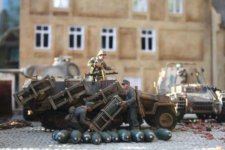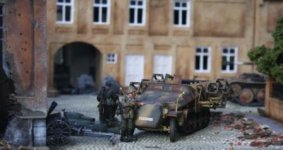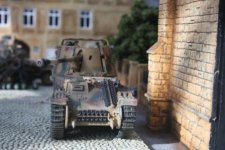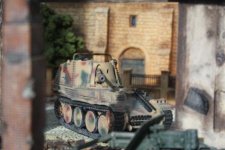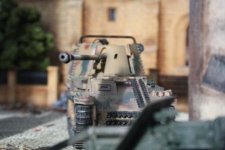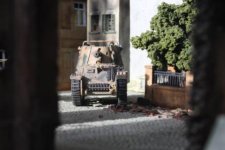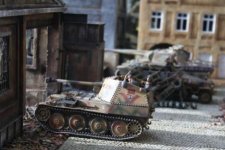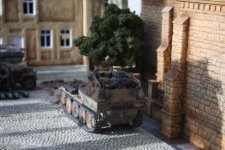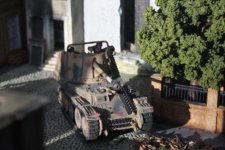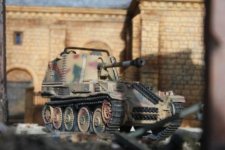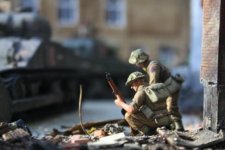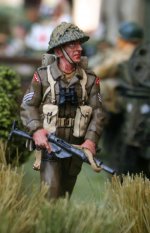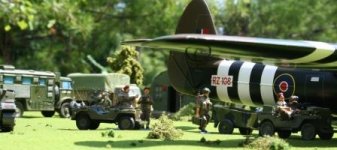You are using an out of date browser. It may not display this or other websites correctly.
You should upgrade or use an alternative browser.
You should upgrade or use an alternative browser.
Battle for Arnhem.... (1 Viewer)
- Thread starter panda1gen
- Start date
panda1gen
Colonel
- Joined
- Jul 29, 2005
- Messages
- 8,154
Re: battle for arnhem....
When the Germans invaded Russia, they found the T34 and KV1 tanks to be resistant, or in the case of the KV1, almost impervious to their 37mm, 50mm AT guns.
They captured huge numbers of Russian field and anti guns, so after modifying them for German use set about fitting them on any suitable obsolete tank chasis.
Later they fitted pak40 75mm AT guns.
They needed to use tracked vehicles due to the relatively poor infrastructure in Russia and the mud in Autumn and Spring - the T34 had light ground pressure and could move all year round.
When the Germans invaded Russia, they found the T34 and KV1 tanks to be resistant, or in the case of the KV1, almost impervious to their 37mm, 50mm AT guns.
They captured huge numbers of Russian field and anti guns, so after modifying them for German use set about fitting them on any suitable obsolete tank chasis.
Later they fitted pak40 75mm AT guns.
They needed to use tracked vehicles due to the relatively poor infrastructure in Russia and the mud in Autumn and Spring - the T34 had light ground pressure and could move all year round.
Attachments
panda1gen
Colonel
- Joined
- Jul 29, 2005
- Messages
- 8,154
panda1gen
Colonel
- Joined
- Jul 29, 2005
- Messages
- 8,154
Re: battle for arnhem....
7.62 cm Pak 36(r)
From Wikipedia, the free encyclopedia
(Redirected from 7.62 cm PaK 36(r))
Jump to: navigation, search
7.62 cm Panzerabwehrkanone 36(Russland)
Pak 36(r) anti-tank gun, displayed on the grounds of CFB Borden. Type anti-tank gun Place of origin Germany Service history Used by Germany Wars World War II Production history Number built 560 ? Specifications Weight 1,710 kg (3,770 lbs) Barrel length bore: 3,680 mm / 48.4 calibers
overall: 3,895 mm / 51.2 calibers (without muzzle brake) Crew 6 Caliber 76.2 mm (3 in) Breech vertical block Recoil hydropneumatic Carriage split trail Elevation 60° Traverse -6° to 18° Rate of fire 10-12 rounds per minute The 7.62 cm Pak 36(r) (7.62 cm Panzerabwehrkanone 36(russland)) was a German anti-tank gun used by the Wehrmacht in World War II. The gun was a conversion of the Soviet 76-mm divisional gun M1936 (F-22).
Contents
[hide]
Like F-22, Pak 36(r) had split-trail carriage with suspension and steel wheels with rubber tires. The gun was equipped with semi-automatic vertical breech block; recoil mechanism consisted of hydraulic recoil buffer and hydropneumatic recuperator. There was no limber; the gun therefore could not be towed by a horse team.
[edit] Development history
Soon after the German invasion of the USSR in 1941, Wehrmacht units encountered new Soviet tanks, the medium T-34 and the heavy KV. Thick sloped armor of these vehicles gave them good degree of protection against German anti-tank weapons. The situation eventually led to requests for more powerful guns that would be able to destroy the aforementioned tanks from long range. Since Germany already had a suitable design, the 7.5 cm Pak 40, it entered production and in November 1941 first pieces were delivered. But until enough of those would be manufactured, some expedient solution was required.
In the early stage of the war, Germans captured a large number (up to 1,300) of Soviet 76-mm divisional guns model 1936 (F-22). Developed with anti-aircraft abilities in mind, the Soviet gun had powerful ballistics; it was also originally intended to use more powerful cartridge than the one eventually adopted. However the design had some shortcomings which made it ineffective in the anti-tank role. In late 1941 German engineers developed a modernization program, which included:


Pak 36(r), CFB Borden.


Pak 36(r), CFB Borden.
7.62 cm Pak 36(r)
From Wikipedia, the free encyclopedia
(Redirected from 7.62 cm PaK 36(r))
Jump to: navigation, search
7.62 cm Panzerabwehrkanone 36(Russland)

Pak 36(r) anti-tank gun, displayed on the grounds of CFB Borden. Type anti-tank gun Place of origin Germany Service history Used by Germany Wars World War II Production history Number built 560 ? Specifications Weight 1,710 kg (3,770 lbs) Barrel length bore: 3,680 mm / 48.4 calibers
overall: 3,895 mm / 51.2 calibers (without muzzle brake) Crew 6 Caliber 76.2 mm (3 in) Breech vertical block Recoil hydropneumatic Carriage split trail Elevation 60° Traverse -6° to 18° Rate of fire 10-12 rounds per minute The 7.62 cm Pak 36(r) (7.62 cm Panzerabwehrkanone 36(russland)) was a German anti-tank gun used by the Wehrmacht in World War II. The gun was a conversion of the Soviet 76-mm divisional gun M1936 (F-22).
Contents
[hide]
- 1 Description
- 2 Development history
- 3 Production
- 4 Employment
- 5 Summary
- 6 Ammunition
- 7 Notes
- 8 References
Like F-22, Pak 36(r) had split-trail carriage with suspension and steel wheels with rubber tires. The gun was equipped with semi-automatic vertical breech block; recoil mechanism consisted of hydraulic recoil buffer and hydropneumatic recuperator. There was no limber; the gun therefore could not be towed by a horse team.
[edit] Development history
Soon after the German invasion of the USSR in 1941, Wehrmacht units encountered new Soviet tanks, the medium T-34 and the heavy KV. Thick sloped armor of these vehicles gave them good degree of protection against German anti-tank weapons. The situation eventually led to requests for more powerful guns that would be able to destroy the aforementioned tanks from long range. Since Germany already had a suitable design, the 7.5 cm Pak 40, it entered production and in November 1941 first pieces were delivered. But until enough of those would be manufactured, some expedient solution was required.
In the early stage of the war, Germans captured a large number (up to 1,300) of Soviet 76-mm divisional guns model 1936 (F-22). Developed with anti-aircraft abilities in mind, the Soviet gun had powerful ballistics; it was also originally intended to use more powerful cartridge than the one eventually adopted. However the design had some shortcomings which made it ineffective in the anti-tank role. In late 1941 German engineers developed a modernization program, which included:


Pak 36(r), CFB Borden.
- Rechambering for a more powerful round. The German cartridge was nearly twice as long as the Soviet one (715 mm vs 385.3 mm) and wider (100 mm vs 90 mm), resulting in 2.4 times larger propellant load.
- Controls were moved to the left side of the barrel, near the sights.
- Recoil mechanism was improved.
- Maximum elevation angle was limited to 18 degrees.
- The carriage was equipped with a new, lower shield.
- Many (but not all) guns were fitted with muzzle brake.


Pak 36(r), CFB Borden.
panda1gen
Colonel
- Joined
- Jul 29, 2005
- Messages
- 8,154
Re: battle for arnhem....
First guns were delivered in April 1942. Until the end of the year Germans converted 358 pieces, 169 in 1943 and 33 in 1944. Additionally, 894 barrels were prepared for use in self-propelled guns. It is likely that these numbers include Pak 39(r), a similarly upgraded 76-mm M1939 (up to 300 pieces).
Production of the ammunition for PaK 36(r) and PaK 39(r)[1] Shell type 1942 1943 1944 Total HE-Frag 769,400 1,071,300 857,700 2,698,400 AP, all types 359,400 597,300 437,300 1,394,000 [edit] Employment
PaK 36(r) saw combat on the Eastern Front and in North Africa. The gun was actively used in both anti-tank and field artillery roles until the end of the war. As late as March 1945 Wehrmacht still possessed 165 Pak 36(r) and Pak 39(r). The scale of use can be illustrated by the amount of ammunition consumed: 49,000 AP and 8,170 subcaliber AP shells in 1942, and 151,390 in 1943. For the sake of comparison, in 1942 the aforementioned Pak 40 fired 42,430 AP and 13,380 HEAT shells; in 1943 the numbers grew significantly to 401,100 AP and 374,000 HEAT.
The modernized barrels were also mounted in the below types of self-propelled guns:
[edit] Summary
When Pak 36(r) reached the battlefield, it was able to destroy any contemporary tank at normal combat ranges. Although the gun was heavier and had somewhat smaller penetration figures than the purpose-built Pak 40, there is no doubt that the modernization of F-22 provided Wehrmacht with very effective anti-tank gun at only fraction of the cost of producing one from scratch.
[edit] Ammunition
Available ammunition[1] Type Model Weight, kg HE weight, g Muzzle velocity, m/s Range, m Armor-piercing shells APCBC/HE 7.62 cm Pzgr.39 7.6 24, phlegmatized RDX 740 4,000 APCR 7.62 cm Pzgr.40 4.065 - 990 700 HEAT shells HEAT 7.62 cm Gr.38 Hl/B 4.62 510 450 1,000 HEAT 7.62 cm Gr.38 Hl/С 5.05 510 450 1,000 High explosive and fragmentation shells HE-Frag 7.62 cm Gr.34 6.25 550, amatol 40/60 550 10,000 Armor penetration table[1] 7.62 cm Pzgr.39 Range, m Meet angle 60°, mm Meet angle 90°, mm 0 108 133 457 98 120 915 88 108 1,372 79 97 1,829 71 87 7.62 cm Pzgr.40 Range, m Meet angle 60°, mm Meet angle 90°, mm 0 152 190 457 118 158 915 92 130 1,372 71 106 1,829 55 84 This data was obtained by German methodics of armor penetration measurement. Exact figures depend on production batch of projectiles and technology of armour manufacturing.
The HEAT projectiles penetrated about 100-115 mm at meet angle 90°.
[edit] Notes
[edit] References
 Wikimedia Commons has media related to: PaK 36(r)
Wikimedia Commons has media related to: PaK 36(r)
First guns were delivered in April 1942. Until the end of the year Germans converted 358 pieces, 169 in 1943 and 33 in 1944. Additionally, 894 barrels were prepared for use in self-propelled guns. It is likely that these numbers include Pak 39(r), a similarly upgraded 76-mm M1939 (up to 300 pieces).
Production of the ammunition for PaK 36(r) and PaK 39(r)[1] Shell type 1942 1943 1944 Total HE-Frag 769,400 1,071,300 857,700 2,698,400 AP, all types 359,400 597,300 437,300 1,394,000 [edit] Employment
PaK 36(r) saw combat on the Eastern Front and in North Africa. The gun was actively used in both anti-tank and field artillery roles until the end of the war. As late as March 1945 Wehrmacht still possessed 165 Pak 36(r) and Pak 39(r). The scale of use can be illustrated by the amount of ammunition consumed: 49,000 AP and 8,170 subcaliber AP shells in 1942, and 151,390 in 1943. For the sake of comparison, in 1942 the aforementioned Pak 40 fired 42,430 AP and 13,380 HEAT shells; in 1943 the numbers grew significantly to 401,100 AP and 374,000 HEAT.
The modernized barrels were also mounted in the below types of self-propelled guns:
- 7.62 cm Pak 36(r) auf Pz.IID Marder II (Sd.Kfz.132) - lightly armoured tank destroyer on Panzer II light tank chassis.
- 7.62 cm Pak 36(r) auf Pz.38(t) Marder III (Sd.Kfz.139) - lightly armoured tank destroyer on Panzer 38(t) light tank chassis.
[edit] Summary
When Pak 36(r) reached the battlefield, it was able to destroy any contemporary tank at normal combat ranges. Although the gun was heavier and had somewhat smaller penetration figures than the purpose-built Pak 40, there is no doubt that the modernization of F-22 provided Wehrmacht with very effective anti-tank gun at only fraction of the cost of producing one from scratch.
[edit] Ammunition
Available ammunition[1] Type Model Weight, kg HE weight, g Muzzle velocity, m/s Range, m Armor-piercing shells APCBC/HE 7.62 cm Pzgr.39 7.6 24, phlegmatized RDX 740 4,000 APCR 7.62 cm Pzgr.40 4.065 - 990 700 HEAT shells HEAT 7.62 cm Gr.38 Hl/B 4.62 510 450 1,000 HEAT 7.62 cm Gr.38 Hl/С 5.05 510 450 1,000 High explosive and fragmentation shells HE-Frag 7.62 cm Gr.34 6.25 550, amatol 40/60 550 10,000 Armor penetration table[1] 7.62 cm Pzgr.39 Range, m Meet angle 60°, mm Meet angle 90°, mm 0 108 133 457 98 120 915 88 108 1,372 79 97 1,829 71 87 7.62 cm Pzgr.40 Range, m Meet angle 60°, mm Meet angle 90°, mm 0 152 190 457 118 158 915 92 130 1,372 71 106 1,829 55 84 This data was obtained by German methodics of armor penetration measurement. Exact figures depend on production batch of projectiles and technology of armour manufacturing.
The HEAT projectiles penetrated about 100-115 mm at meet angle 90°.
[edit] Notes
[edit] References
- Gander, Terry and Chamberlain, Peter. Weapons of the Third Reich: An Encyclopedic Survey of All Small Arms, Artillery and Special Weapons of the German Land Forces 1939-1945. New York: Doubleday, 1979 ISBN 0-385-15090-3
- Hogg, Ian V. German Artillery of World War Two. 2nd corrected edition. Mechanicsville, PA: Stackpole Books, 1997 ISBN 1-85367-480-X
 Wikimedia Commons has media related to: PaK 36(r)
Wikimedia Commons has media related to: PaK 36(r) - Shirokorad A. B. - The God of War of the Third Reich - M. AST, 2002 (Широкорад А. Б. - Бог войны Третьего рейха. — М.,ООО Издательство АСТ, 2002., ISBN 5-17-015302-3)
- Ivanov A. - Artillery of Germany in Second World War - SPb Neva, 2003 (Иванов А. - Артиллерия Германии во Второй Мировой войне. — СПб., Издательский дом «Нева», 2003., ISBN 5-7654-2634-4)
- Klyuev A. etc. - German Artillery Ammunition Reference Book - M., 1943 (А.Клюев и др - Справочник по комплектации боеприпасов германской артиллерии. — М., 1943)
panda1gen
Colonel
- Joined
- Jul 29, 2005
- Messages
- 8,154
Re: battle for arnhem....
This is the Marder Ausf M version.........
Marder III
From Wikipedia, the free encyclopedia
Jump to: navigation, search
Marder III
Marder III Ausf.M Type Tank destroyer Place of origin
 Nazi Germany Service history In service 1942 to 1945 Used by Nazi Germany Wars World War II Production history Designed 1942 Produced 1942 to 1944 Specifications Weight 10,670 kg (23,523 lbs) Length 4.65 m (15.25 ft) Width 2.35 m (7.70 ft) Height 2.48 m (8.13 ft) Crew 4 Primary
Nazi Germany Service history In service 1942 to 1945 Used by Nazi Germany Wars World War II Production history Designed 1942 Produced 1942 to 1944 Specifications Weight 10,670 kg (23,523 lbs) Length 4.65 m (15.25 ft) Width 2.35 m (7.70 ft) Height 2.48 m (8.13 ft) Crew 4 Primary
armament 7.62 cm PaK 36(r) or 7.5 cm PaK 40 The Marder III is the name for a series of World War II German tank destroyers built on the chassis of the Panzer 38(t). German word "Marder" means "marten" in English. They were in production from 1942 to 1944 and served on all fronts until the end of the war.
Contents
[hide]
[edit] History
Even in the early stages of Operation Barbarossa, the Wehrmacht already felt the need for a more mobile and more powerful anti-tank solution than the existing towed anti-tank guns or tank destroyers like the Panzerjäger I. This need became urgent in June 1941, with the appearance of the new Soviet tanks like the T-34 and KV-1.
As an interim solution, it was decided to use captured French vehicles like the Lorraine (Marder I), obsolete tanks such as German Panzer II (Marder II), and Czech-supplied 38(t) (Marder III) as the base for makeshift tank destroyers. The result was the Marder series, which were armed with either captured Soviet 76.2mm F-22 Model 1936 divisional field guns, or 75 mm PaK 40 anti-tank guns. Due to weight and space constraints of these small chassis, Marder series were not fully armored. Weak armor protection was provided only for the front and sides. All Marder series had open tops. Some were issued with canvas tops to protect the crew from the elements.
From early 1944, fully armored vehicles such as the Hetzer, StuG III, StuG IV, Jagdpanzer IV, Elefant, Jagdpanther and Jagdtiger increasingly took over the role of tank destroyers and the weakly armored Marder series were phased out of production, however, they served until the end of the conflict.
[edit] Development


Marder III (Sd.Kfz.139) on display at the US Army Ordnance Museum in Aberdeen


Marder III Ausf.H (Sd.Kfz.138) on display at the Sinsheim Auto & Technik Museum in Germany


Marder III Ausf.M on display at the Musée des Blindés at Saumur


Marder III on display at Victory Park in Moscow, 2004.
[edit] Marder III, Sd.Kfz. 139
While the Panzer 38(t) had largely become obsolete as a tank in early 1942, it was still an excellent platform for adaptation into a tank destroyer, among other roles. Since the Soviet 76.2 mm field gun was captured in large quantities, the decision was made to mate this gun to the Panzer 38(t).
To do so, the turret and upper superstructure of the Panzer 38 were removed and a new superstructure was bolted on to the chassis. The upper structure mounted the gun and an extended gun shield, giving very limited protection for the commander and the loader. Armour protection overall ranged from 10 to 50 mm. The gun, commander and loader were located on top of the engine deck. It had higher silhouette than Panzer 38, which made it more vulnerable to enemy fire.
The now-called 7.62 cm PaK 36(r) was rechambered to be able to use standard German 75 mm ammunition, of which 30 rounds could be carried inside the vehicle. Apart from the main gun, there was a 7.92 mm machine gun mounted in the hull.
This tank destroyer was put into production as the Panzerjäger 38(t) für 7.62 cm PaK 36(r), Sd.Kfz. 139. A total of 363 of this Marder III variant were built from April 1942 to 1943.
This is the Marder Ausf M version.........
Marder III
From Wikipedia, the free encyclopedia
Jump to: navigation, search
Marder III

Marder III Ausf.M Type Tank destroyer Place of origin

armament 7.62 cm PaK 36(r) or 7.5 cm PaK 40 The Marder III is the name for a series of World War II German tank destroyers built on the chassis of the Panzer 38(t). German word "Marder" means "marten" in English. They were in production from 1942 to 1944 and served on all fronts until the end of the war.
Contents
[hide]
[edit] History
Even in the early stages of Operation Barbarossa, the Wehrmacht already felt the need for a more mobile and more powerful anti-tank solution than the existing towed anti-tank guns or tank destroyers like the Panzerjäger I. This need became urgent in June 1941, with the appearance of the new Soviet tanks like the T-34 and KV-1.
As an interim solution, it was decided to use captured French vehicles like the Lorraine (Marder I), obsolete tanks such as German Panzer II (Marder II), and Czech-supplied 38(t) (Marder III) as the base for makeshift tank destroyers. The result was the Marder series, which were armed with either captured Soviet 76.2mm F-22 Model 1936 divisional field guns, or 75 mm PaK 40 anti-tank guns. Due to weight and space constraints of these small chassis, Marder series were not fully armored. Weak armor protection was provided only for the front and sides. All Marder series had open tops. Some were issued with canvas tops to protect the crew from the elements.
From early 1944, fully armored vehicles such as the Hetzer, StuG III, StuG IV, Jagdpanzer IV, Elefant, Jagdpanther and Jagdtiger increasingly took over the role of tank destroyers and the weakly armored Marder series were phased out of production, however, they served until the end of the conflict.
[edit] Development


Marder III (Sd.Kfz.139) on display at the US Army Ordnance Museum in Aberdeen


Marder III Ausf.H (Sd.Kfz.138) on display at the Sinsheim Auto & Technik Museum in Germany


Marder III Ausf.M on display at the Musée des Blindés at Saumur


Marder III on display at Victory Park in Moscow, 2004.
[edit] Marder III, Sd.Kfz. 139
While the Panzer 38(t) had largely become obsolete as a tank in early 1942, it was still an excellent platform for adaptation into a tank destroyer, among other roles. Since the Soviet 76.2 mm field gun was captured in large quantities, the decision was made to mate this gun to the Panzer 38(t).
To do so, the turret and upper superstructure of the Panzer 38 were removed and a new superstructure was bolted on to the chassis. The upper structure mounted the gun and an extended gun shield, giving very limited protection for the commander and the loader. Armour protection overall ranged from 10 to 50 mm. The gun, commander and loader were located on top of the engine deck. It had higher silhouette than Panzer 38, which made it more vulnerable to enemy fire.
The now-called 7.62 cm PaK 36(r) was rechambered to be able to use standard German 75 mm ammunition, of which 30 rounds could be carried inside the vehicle. Apart from the main gun, there was a 7.92 mm machine gun mounted in the hull.
This tank destroyer was put into production as the Panzerjäger 38(t) für 7.62 cm PaK 36(r), Sd.Kfz. 139. A total of 363 of this Marder III variant were built from April 1942 to 1943.
Attachments
panda1gen
Colonel
- Joined
- Jul 29, 2005
- Messages
- 8,154
Re: battle for arnhem....
Marder III Ausf.M, Sd.Kfz. 138
The last Marder III variant was based on the Panzer 38(t) Ausf. M (with Ausf. M standing for Mittelmotor (middle engine), again armed with the 75 mm PaK 40 anti-tank gun. In this variant, the engine was moved from the rear to the middle between driver and the rest of the crew. Because there was no engine in the rear, the gun and the crew did not have to sit on top of the engine deck as in previous models. The fighting compartment could be lowered down to the bottom floor level where the engine used to be. This decreased crew exposure, as well as visibility. Unlike the previous two Marder IIIs, the fighting compartment was closed at the rear protecting the crew up to their mid-section. It stayed open-topped. It could only carry 27 rounds of ammunition. The machinegun port at the front was eliminated in the Ausf. M, instead an MG 34 or MG 42 was carried by the crew. In the previous two models, the commander served as a gunner. However, in Ausf. M, the radio man moved to the rear with the commander and gunner, serving as a loader. Combat effectiveness increased because the vehicle commander was freed from manning the gun.
The Ausf. M was the variant which was produced in the largest numbers, some 975 vehicles being manufactured in 1943 and early 1944. Its full name was the Panzerjäger 38(t) mit 7.5 cm PaK 40/3 Ausf.M, Sd.Kfz. 138.
[edit] Combat history


The Marder III Ausf. H on the Eastern Front.
The various Marder IIIs fought on all fronts of the war, with the Sd.Kfz. 139 being used mainly at the Eastern Front, though some also fought in Tunisia. Even in February 1945 some 350 Ausf M were still in service.
The Marder IIIs were used by the Panzerjäger Abteilungen of the Panzer divisions of both the Wehrmacht and the Waffen SS, as well as several Luftwaffe units, like the Hermann Göring division.
The Marders were mechanically reliable, as with all vehicles on the Czechoslovak 38t chassis. Their firepower was sufficient to destroy the majority of Soviet tanks on the battlefield at combat range.
The Marder's weaknesses were mainly related to survivability. The combination of a high silhouette and open-top armor protection made them vulnerable to indirect artillery fire. The armor was also quite thin, making them highly vulnerable to enemy tanks and to close-range machinegun fire.
The Marders were not assault vehicles or tank substitutes; the open top meant that operations in urban areas or other close-combat situations were very risky. They were best employed in defensive or overwatch roles. Despite their weaknesses they were much more effective than the towed antitank guns they replaced.
[edit] External links
 Wikimedia Commons has media related to: Marder III
Wikimedia Commons has media related to: Marder III
Marder III Ausf.M, Sd.Kfz. 138
The last Marder III variant was based on the Panzer 38(t) Ausf. M (with Ausf. M standing for Mittelmotor (middle engine), again armed with the 75 mm PaK 40 anti-tank gun. In this variant, the engine was moved from the rear to the middle between driver and the rest of the crew. Because there was no engine in the rear, the gun and the crew did not have to sit on top of the engine deck as in previous models. The fighting compartment could be lowered down to the bottom floor level where the engine used to be. This decreased crew exposure, as well as visibility. Unlike the previous two Marder IIIs, the fighting compartment was closed at the rear protecting the crew up to their mid-section. It stayed open-topped. It could only carry 27 rounds of ammunition. The machinegun port at the front was eliminated in the Ausf. M, instead an MG 34 or MG 42 was carried by the crew. In the previous two models, the commander served as a gunner. However, in Ausf. M, the radio man moved to the rear with the commander and gunner, serving as a loader. Combat effectiveness increased because the vehicle commander was freed from manning the gun.
The Ausf. M was the variant which was produced in the largest numbers, some 975 vehicles being manufactured in 1943 and early 1944. Its full name was the Panzerjäger 38(t) mit 7.5 cm PaK 40/3 Ausf.M, Sd.Kfz. 138.
[edit] Combat history


The Marder III Ausf. H on the Eastern Front.
The various Marder IIIs fought on all fronts of the war, with the Sd.Kfz. 139 being used mainly at the Eastern Front, though some also fought in Tunisia. Even in February 1945 some 350 Ausf M were still in service.
The Marder IIIs were used by the Panzerjäger Abteilungen of the Panzer divisions of both the Wehrmacht and the Waffen SS, as well as several Luftwaffe units, like the Hermann Göring division.
The Marders were mechanically reliable, as with all vehicles on the Czechoslovak 38t chassis. Their firepower was sufficient to destroy the majority of Soviet tanks on the battlefield at combat range.
The Marder's weaknesses were mainly related to survivability. The combination of a high silhouette and open-top armor protection made them vulnerable to indirect artillery fire. The armor was also quite thin, making them highly vulnerable to enemy tanks and to close-range machinegun fire.
The Marders were not assault vehicles or tank substitutes; the open top meant that operations in urban areas or other close-combat situations were very risky. They were best employed in defensive or overwatch roles. Despite their weaknesses they were much more effective than the towed antitank guns they replaced.
[edit] External links
 Wikimedia Commons has media related to: Marder III
Wikimedia Commons has media related to: Marder III - Achtung Panzer!
- OnWar (Marder III, Sd.Kfz.139, (Marder III, Ausf.M, Sd.Kfz.138
- World War II vehicles
- Captured German vehicles - A PDF file presenting the German vehicles based on captured and modified foreign equipment (PzKpfw. 35(t), PzKpfw 38(t), 10.5 cm leFH 18(Sf) auf Geschützwagen, Marder I, Panzerjäger I, Marder III, Grille, Munitionspanzer 38(t)) still existing in the world
Attachments
Users who are viewing this thread
Total: 2 (members: 0, guests: 2)


